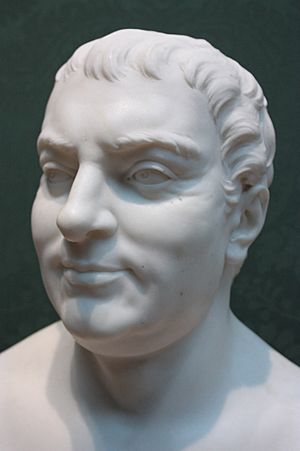Thomas Hollis (1720–1774) facts for kids

Thomas Hollis (born April 14, 1720, in London – died January 1, 1774) was an English thinker and writer. He believed strongly in freedom and worked to share his ideas with others.
Early Life and Education
Thomas Hollis started his schooling at Adams Grammar School when he was young. He studied there until he was 10 years old. After that, he went to school in St. Albans until he was 15. To prepare for a career, he then traveled to Amsterdam. There, he learned French, Dutch, and how to manage money.
When his father passed away in 1735, John Hollister became his guardian. During this time, John Ward from Gresham College in London helped train him for public service. Hollis became very wealthy, inheriting money from his father, grandfather, and uncle.
Travels and Love for Art
From 1748 to 1749, Hollis traveled around Europe with his friend Thomas Brand. He went on another trip by himself from 1750 to 1753. During these travels, he met many important French thinkers. He also met several Italian artists, like Camillo Paderni, who wrote to him about old Roman ruins.
When he returned to England, Hollis became an active member of the Royal Society of Arts. He suggested that the famous artist Piranesi join the Society of Antiquaries. Hollis also asked the artist Cipriani to create many artworks. He was good friends with the painter Canaletto in England. Hollis asked Canaletto to paint six pictures for him. One of these paintings showed Hollis, his friend Thomas Brand, and his servant at Old Walton Bridge. Another showed the inside of the rotunda at Ranelagh. In 1757, he became a Fellow of the Royal Society, which is a group for important scientists.
Hollis knew many influential people. These included Francis Blackburne, Theophilus Lindsey, John Wilkes, and even important members of the government like William Pitt. He also helped manage hospitals like Guy's and St Thomas's, and places that cared for people in need.
Sharing Ideas Through Books
Thomas Hollis believed that sharing the right books could help protect and advance freedom in England. Starting in 1754, he began reprinting and sharing important books about government. These included works from the 1600s by writers like John Toland, Marchamont Nedham, Henry Neville, and Philip Sidney. He also reprinted John Locke's famous book, Two Treatises of Government.
From 1760, Hollis worked with a bookseller named Andrew Millar. They published books that supported a government where people had more power, like a republic. These books included works by John Milton (1760), John Toland (1760), Algernon Sidney (1763), Henry Neville (1763), and John Locke (1764). Hollis made sure these books were beautifully bound. They often had special designs like a liberty cap or an owl, which were symbols of freedom. He also published writings by American colonists about the Stamp Act crisis. This included John Adams's Dissertation on the Canon and the Feudal Law (1765).
At first, Hollis sent these books to libraries all over Britain and Europe. Later, he started sending many books to America. He was a great supporter of American colleges, especially Harvard. He sent them many books, often decorated with symbols of freedom. His main contact in America was Jonathan Mayhew of Boston. After Mayhew died in 1766, Andrew Eliot became his contact. Hollis also gave many donations to the library in Berne and the University of Leiden Library.
Hollis was a friend and supporter of the historian William Harris (historian).
Thomas Hollis passed away suddenly on January 1, 1774. He was not married. After leaving some smaller gifts, he left most of his property to Thomas Brand. Thomas Brand then added Hollis's name to his own.

